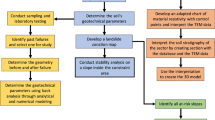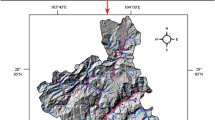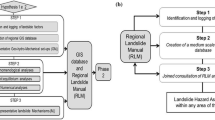Summary
There is a need for a simple method of determing relative landslip risk in clay slopes for land use planning and insurance purposes. A method is suggested which combines plasticity index, water conditions, slope angle, slope complexity and land use. The formulation is described and discussed and some examples from Tasmania are given.
Résumé
Il y a besoin d’une méthode simple à déterminer le risque de glissement enpentes d’argle dans le but de la planification et de l’assurance. La méthode proposée combine la plasticité, les conditions de l’eau, l’angle de la pente, la complexité de la pente et l’utilisation de terrain. La formulation est décrite, discutée et illustrée par quelques exemples provenants de la Tasmanie.
Similar content being viewed by others
References
BARTON H.—LIEN R.—LUNDE J. /1974/: Engineering classification of rock masses for the design of tunnel support. Rock Mechanics 6, 4, 189–236.
BIENIAWSKI Z.T. /1973/: Engineering classification of jointed rock masses. Trans. S. Afr. Instn. Civ. Engrs., 15, 335–342.
KNIGHTS C.J.—MATTHEWS W.L. /1977/: A landslip study in Tertiary sediments. Bull. int. Ass. engng Geol. /in press/.
SEED H. B.—WOODWARD R.J. jr—LUNDGREN R. /1964a/: Clay mineralogical aspects of the Atterberg limits. Proc. Am. Soc. Civ. Engrs. 90 (SM4), 107–131.
SEED H.B.—WOODWARD R.J. Jr—LUNDGREN R. /1964/: Fundamental aspects of the Atterberg limits. Proc. Am. Soc. Civ. Engrs, 90/SM6/, 75–106.
SKEMPTON A.W. /1964/: Long term stability of clay slopes. Geotechnique 14, 2, 77–101.
SLOANE, D.J. /1977/: The Beauty Point landslip area Unpubl. Rep. Dep. Mines Tasm. 1977/7.
STEVENSON P.C. /1972/: The assessment of land stability at Panorama Heights subdivision, Devonport. Unpubl. Rep. Dep. Mines Tasm. 1972/11.
STEVENSON P.C. /1975/: A predictive landslip survey and its social impact. Proc.2nd Aust.-N.Z. Conf. Geomech., Brisbane, 10–15
Author information
Authors and Affiliations
Additional information
Geological Survey of Tasmania-Department of Mines, P. O. Box 124B, Hobart, Tasmania
Rights and permissions
About this article
Cite this article
Stevenson, P.C. An empirical method for the evaluation of relative landslip risk. Bulletin of the International Association of Engineering Geology 16, 69–72 (1977). https://doi.org/10.1007/BF02591451
Published:
Issue Date:
DOI: https://doi.org/10.1007/BF02591451




